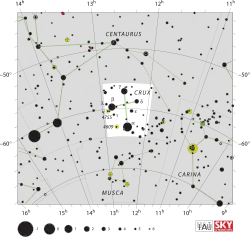Lambda Crucis
λ Crucis, Latinized as Lambda Crucis, is a single,[10] variable star in the southern constellation Crux, near the constellation border with Centaurus. It is visible to the naked eye as a faint, blue-white hued point of light with an apparent visual magnitude that fluctuates around 4.62.[2] The star is located approximately 384 light-years distant from the Sun based on parallax, and is drifting further away with a radial velocity of +12 km/s.[5] It is a proper motion member of the Lower-Centaurus Crux sub-group in the Scorpius-Centaurus OB association, the nearest such association of co-moving massive stars to the Sun.[6]

| |
| Observation data Epoch J2000 Equinox J2000 | |
|---|---|
| Constellation | Crux |
| Right ascension | 12h 54m 39.18258s[1] |
| Declination | −59° 08′ 48.1229″[1] |
| Apparent magnitude (V) | 4.62[2] |
| Characteristics | |
| Evolutionary stage | main sequence |
| Spectral type | B4 Vne[3] |
| U−B color index | –0.60[4] |
| B−V color index | –0.15[4] |
| Variable type | β Cep?[2] |
| Astrometry | |
| Radial velocity (Rv) | +12.0±4.2[5] km/s |
| Proper motion (μ) | RA: –32.92[1] mas/yr Dec.: –14.60[1] mas/yr |
| Parallax (π) | 8.50 ± 0.21[1] mas |
| Distance | 384 ± 9 ly (118 ± 3 pc) |
| Absolute magnitude (MV) | –1.2[6] |
| Details | |
| Mass | 5.0±0.1[7] M☉ |
| Radius | 3.00[8] R☉ |
| Luminosity | 790[6] L☉ |
| Surface gravity (log g) | 3.01[8] cgs |
| Temperature | 16,500[8] K |
| Rotational velocity (v sin i) | 290[8] km/s |
| Age | 53.3±8.1[7] Myr |
| Other designations | |
| Database references | |
| SIMBAD | data |
λ Crucis is listed in the General Catalogue of Variable Stars as a possible β Cephei-type variable. Its brightness varies with an amplitude of 0m.02 over a period of 0.3951 days.[2] However, it is currently thought more likely to be a different type of variable,[11] possibly a λ Eridani variable or rotating ellipsoidal variable.[12][13]
This object is a B-type main-sequence star with a stellar classification of B4 Vne,[3] where the suffix notation indicates "nebulous" (broad) lines due to rapid rotation, along with emission lines from circumstellar material. It is around 53[7] million years old and is spinning rapidly with a projected rotational velocity of 341 km/s.[14] The star has five[7] times the mass of the Sun and about 3.0[8] times the Sun's radius. It is radiating 790[6] times the luminosity of the Sun from its photosphere at an effective temperature of 16,500 K.[8]
References
- van Leeuwen, F. (2007). "Validation of the new Hipparcos reduction". Astronomy and Astrophysics. 474 (2): 653–664. arXiv:0708.1752. Bibcode:2007A&A...474..653V. doi:10.1051/0004-6361:20078357.
- Samus, N. N.; et al. (2017). "General Catalogue of Variable Stars". Astronomy Reports. 5.1. 61 (1): 80–88. Bibcode:2017ARep...61...80S. Retrieved 2019-09-16.
- Levenhagen, R. S.; Leister, N. V. (2006). "Spectroscopic analysis of southern B and Be stars". Monthly Notices of the Royal Astronomical Society. 371: 252. arXiv:astro-ph/0606149. Bibcode:2006MNRAS.371..252L. doi:10.1111/j.1365-2966.2006.10655.x.
- Johnson, H. L.; et al. (1966). "UBVRIJKL photometry of the bright stars". Communications of the Lunar and Planetary Laboratory. 4 (99). Bibcode:1966CoLPL...4...99J.
- Evans, D. S. (June 20–24, 1966). "The Revision of the General Catalogue of Radial Velocities". In Batten, Alan Henry; Heard, John Frederick (eds.). Determination of Radial Velocities and their Applications, Proceedings from IAU Symposium no. 30. University of Toronto: International Astronomical Union. Bibcode:1967IAUS...30...57E.
- de Geus, E. J.; et al. (June 1989). "Physical parameters of stars in the Scorpio-Centaurus OB association". Astronomy and Astrophysics. 216 (1–2): 44–61. Bibcode:1989A&A...216...44D.
- Tetzlaff, N.; et al. (January 2011). "A catalogue of young runaway Hipparcos stars within 3 kpc from the Sun". Monthly Notices of the Royal Astronomical Society. 410 (1): 190–200. arXiv:1007.4883. Bibcode:2011MNRAS.410..190T. doi:10.1111/j.1365-2966.2010.17434.x.
- Arcos, C.; Kanaan, S.; Chávez, J.; Vanzi, L.; Araya, I.; Curé, M. (2018), "Stellar parameters and H α line profile variability of be stars in the BeSOS survey", Monthly Notices of the Royal Astronomical Society, 474 (4): 5287–5299, arXiv:1711.08675, Bibcode:2018MNRAS.474.5287A, doi:10.1093/mnras/stx3075
- "lam Cru". SIMBAD. Centre de données astronomiques de Strasbourg. Retrieved 2019-09-16.
- Rizzuto, A. C.; et al. (December 2013), "Long-baseline interferometric multiplicity survey of the Sco-Cen OB association", Monthly Notices of the Royal Astronomical Society, 436 (2): 1694–1707, arXiv:1309.3811, Bibcode:2013MNRAS.436.1694R, doi:10.1093/mnras/stt1690
- Stankov, Anamarija; Handler, Gerald (2005), "Catalog of Galactic β Cephei Stars", The Astrophysical Journal Supplement Series, 158 (2): 193–216, arXiv:astro-ph/0506495, Bibcode:2005ApJS..158..193S, doi:10.1086/429408
- Balona, L. A. (1995), "Tests of the pulsation and starspot models for the periodic be stars", Monthly Notices of the Royal Astronomical Society, 277 (4): 1547–1554, Bibcode:1995MNRAS.277.1547B, doi:10.1093/mnras/277.4.1547
- Morris, S. L. (1985), "The ellipsoidal variable stars", The Astrophysical Journal, 295: 143, Bibcode:1985ApJ...295..143M, doi:10.1086/163359
- Uesugi, Akira; Fukuda, Ichiro (1970). "Catalogue of rotational velocities of the stars". Contributions from the Institute of Astrophysics and Kwasan Observatory. University of Kyoto. Bibcode:1970crvs.book.....U.